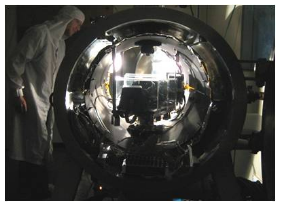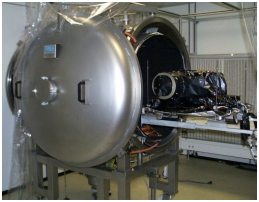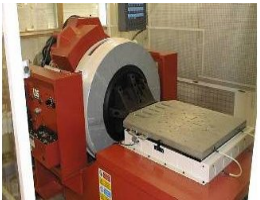AHEAD 2015-2019
Web site: CENTRE SPATIAL AIT/V
Description of the infrastructure
One of the main assets of LAM is the synergy from the collaboration in a same location of several research teams working in astrophysics, a research team in optics for astrophysics, and high-tech engineering teams specialized in optics and opto-mechanics equipped with major facilities for space and ground-based instruments at the best international standards with 1000 m2 (ISO5-ISO8) clean rooms.
These facilities have been organized in a technical platform open to external academic research or industrial partners, which includes a Space Qualification Center (SPATIAL) and a Robotized Polishing Center (POLARIS). The co-location of astrophysical research and engineering teams at LAM provides frequent and easy interactions, as well as a continuing optimization, an extremely favorable context for the emergence of new observational approaches, which are backed by an active R&D. It is on this basis that LAM prepares the future by designing, developing, testing and calibrating the innovative instruments for the next generation of space and ground-based observatories.
The SPATIAL technological facility at LAM is a space AIT/AIV center with a series of equipements dedicated to assembly, integration, tests and calibration of components and instruments with opto-mechanical core in space environment conditions (vibrations, vacuum et cryogenics chambers up to 80m 3 ).
Their design has been made in anticipation of the next generation projects, particularly for the next space missions of ESA. These facilities have been conceived from the onset to be opened to LAM teams and partner institutes or agencies (CNES, ESA, ESO,…), as well as to any research institute or company requiring facilities of this kind.
This space AIT/AIV center provides the means for Assembly (mechnical tools, 3D metrology), Integration (clean room equipment, E.G.S.E), Tests/Qualification/Acceptance (optical metrology, transmission and reflexion measurements, vibration facility, vacuum/cryogenic chambers with stabilised optical bench) and Calibrations (optical benches of 0.8, 6 and 45 m 3 with I.R. spectroscopy capabilities).
The SPATIAL technological facility can provide a set of 940 m2 ISO5, ISO7 and ISO8 clean rooms, controlled according to the standard document ECSS-Q-70-ST-01-C “Cleanliness and Contamination control” with a temperature of 22°C +/- 3° and a humidity ratio of 60 % +/-10%. The floors of all the rooms are electrically conductive to allow for the flow of the electrostatic loads.
This facility also includes a set of thermal/vaccum chambers, in an ISO8 environment, with various performances:
250 litres cryostat (length 1.2m and 0.5m Ø), with 10 -6 mbar vacuum and down to 5K temperature capability, 2.5m 3 cryostat (length 1.4m and 1.0m Ø), with 10 -6 mbar vacuum and 77K to 323K temperature capability, 45m 3 cryostat (length 6.0m and 4.0m Ø), with 10 -6 mbar vacuum and 77K to 323K temperature capability and vibration control at 10 -7 g level on the 5-100Hz range.
This set of vacuum/thermal chambers is completed with vibration test equipment composed by a 3 axis 35KN air cooled shaker with a 600x600mm interface table and 22 channels for signal conditioning and accelerometers.

The LAM SPATIAL facility is already used in a number of research programs in the framework of international consortia (i.e NISP instrument for the Euclid ESA mission), on a scientific collaboration basis. In this case, the running and maintenance costs, as well as investments for the upgrade of the available instrumentation or development of a specific one, are covered by institutes funding (CNRS/AMU/CNES) and the associated research/scientific programs.
The facility is also offered to external academic or industrial teams in the basis of scientific/technical service for R&D, prototyping or qualification process of various opto-mechanical, mechanical or electronics systems or instruments. In this case external teams cover all their travel and living expenses and the facility running costs, including those of the LAM scientific and technical people involved. The LAM facility team provides scientific/technical assistance for the preparation of the measurements runs, conducts the measurements runs with the external teams, and delivers a final measurements analysis report. If necessary LAM provides a small mechanical support for interface design and realization.
During the H2020 program we plan to offer to external visiting teams, at a reduced cost, a level of scientific and technical support equivalent to those usually offered to laboratories or industrial team, with an additional support to the selected external teams for travel and living expenses. In particular with EU funds, for each measurement run at SPATIAL facilities, we plan to support 50% of the facility running cost, including FTE costs of the LAM facility team involved.



